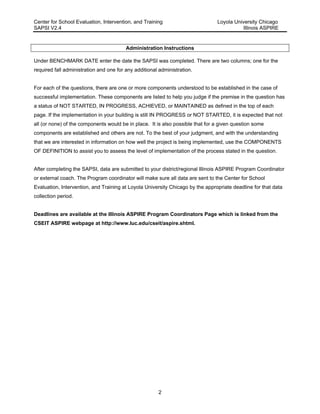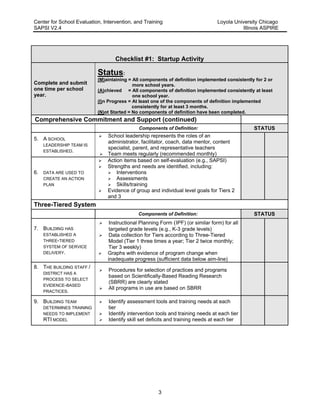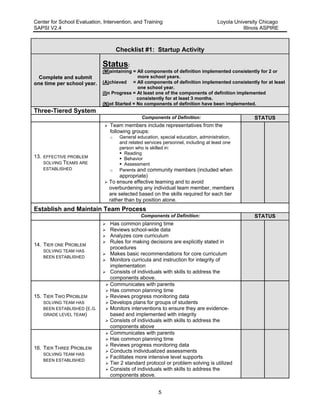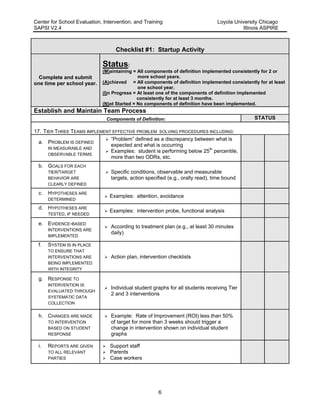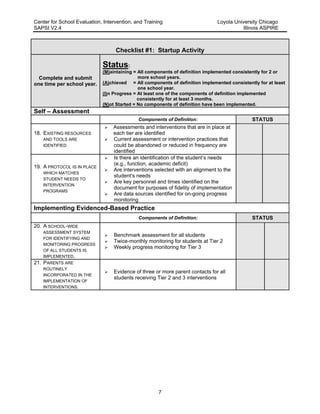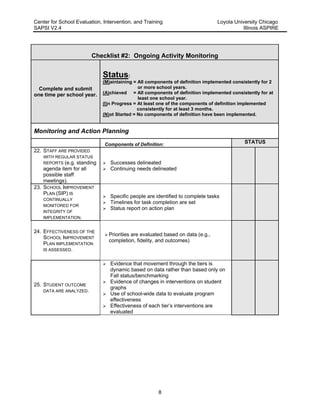ASPIRE_SAPSIv2.4
- 1. Center for School Evaluation, Intervention, and Training Loyola University Chicago SAPSI V2.4 Illinois ASPIRE 1 SELF-ASSESSMENT OF PROBLEM SOLVING IMPLEMENTATION (SAPSI V2.4) ADMINISTRATIVE INSTRUCTIONS Purpose Part of the Illinois ASPIRE project entails assessing the implementation of the problem solving process at the building level. The Self-Assessment of Problem Solving Implementation (SAPSI) checklist monitors ongoing efforts to establish permanent problem solving procedures, tools and products. The following categories of products are those of interest for the evaluation process and were considered in developing the SAPSI questions. Categories of Products Instructional Planning Forms Screening data (CBM, SWIS) Evidence of progress monitoring (Tier 1, Tier 2, Tier 3,Graphs) Case management documentation (student level--choose every 10th case) Training (Training Logs or Sign in sheets) School Improvement Plans Administration The SAPSI is to be administered in schools participating as data collection sites under Illinois ASPIRE. The program coordinator or internal coach at the building level completes the survey with the building team. Timeline for administration The SAPSI is required to be administered once each academic year in the fall. However it may be administered at anytime in order to assist with action planning. Data are to be submitted to your regional coordinator within the deadlines set by the evaluation staff. Detailed information regarding dates to send data back to Loyola University Chicago are available at the Illinois ASPIRE Program Coordinators Page which is linked from the CSEIT ASPIRE webpage at http://www.luc.edu/cseit/aspire.shtml.
- 2. Center for School Evaluation, Intervention, and Training Loyola University Chicago SAPSI V2.4 Illinois ASPIRE 2 Administration Instructions Under BENCHMARK DATE enter the date the SAPSI was completed. There are two columns; one for the required fall administration and one for any additional administration. For each of the questions, there are one or more components understood to be established in the case of successful implementation. These components are listed to help you judge if the premise in the question has a status of NOT STARTED, IN PROGRESS, ACHIEVED, or MAINTAINED as defined in the top of each page. If the implementation in your building is still IN PROGRESS or NOT STARTED, it is expected that not all (or none) of the components would be in place. It is also possible that for a given question some components are established and others are not. To the best of your judgment, and with the understanding that we are interested in information on how well the project is being implemented, use the COMPONENTS OF DEFINITION to assist you to assess the level of implementation of the process stated in the question. After completing the SAPSI, data are submitted to your district/regional Illinois ASPIRE Program Coordinator or external coach. The Program coordinator will make sure all data are sent to the Center for School Evaluation, Intervention, and Training at Loyola University Chicago by the appropriate deadline for that data collection period. Deadlines are available at the Illinois ASPIRE Program Coordinators Page which is linked from the CSEIT ASPIRE webpage at http://www.luc.edu/cseit/aspire.shtml.
- 3. Center for School Evaluation, Intervention, and Training Loyola University Chicago SAPSI V2.4 Illinois ASPIRE 1 Illinois ASPIRE Self-Assessment of Problem Solving Implementation (SAPSI v2.4) School Name Date of Report District Name & Number County INSTRUCTIONS Complete and submit one time per school year. The problem solving team should complete this checklist once in the fall to monitor activities for implementation of problem-solving tasks in the school. Completed forms can be faxed or emailed to your Regional Evaluation Coordinator. Problem Solving Team Members NAME TITLE Person(s) Completing Report NAME NAME
- 4. Center for School Evaluation, Intervention, and Training Loyola University Chicago SAPSI V2.4 Illinois ASPIRE 2 Checklist #1: Startup Activity Complete and submit one time per school year. Status: (M)aintaining = All components of definition implemented consistently for 2 or more school years. (A)chieved = All components of definition implemented consistently for at least one school year. (I)n Progress = At least one of the components of definition implemented consistently for at least 3 months. (N)ot Started = No components of definition have been implemented. Benchmark Dates Date 1 (MM/DD/Y Y) Date 2 (MM/DD/Y Y) Comprehensive Commitment and Support Components of Definition: STATUS 1. DISTRICT LEVEL LEADERSHIP PROVIDES ACTIVE COMMITMENT AND SUPPORT. ’āś Leadership team meets regularly (recommended monthly) ’āś RtI and problem solving implementation are included in district and school board goals ’āś Statement is issued about districtŌĆÖs adoption of multi- tiered, early intervening services model and SLD ’āś Overview of multi-tiered early intervening services model and district commitment is presented to staff, community members, and school board members 2. FACULTY AND STAFF SUPPORT THE DEVELOPMENT OF COMMUNITY AND PARENTAL AWARENESS ’āś Present overview of multi-tiered early intervention services model and district commitment to community members ’āś Present overview of multi-tiered early intervention services model and district commitment to School Board Members 3. THE BUILDING LEADERSHIP PROVIDES SUPPORT AND ACTIVE INVOLVEMENT (I.E. PRINCIPAL ACTIVELY INVOLVED IN LEADERSHIP TEAM MEETINGS). ’āś Standing agenda item for all staff meetings or has established communication process to share information with staff ’āś Professional development communities are created with targeted content related to RtI and problem solving ’āś One of the top 3 goals on School Improvement Plan (SIP) 4. FACULTY/STAFF SUPPORT AND ARE ACTIVELY INVOLVED WITH PROBLEM SOLVING. ’āś 80% of faculty document support ’āś Three year timeline
- 5. Center for School Evaluation, Intervention, and Training Loyola University Chicago SAPSI V2.4 Illinois ASPIRE 3 Checklist #1: Startup Activity Complete and submit one time per school year. Status: (M)aintaining = All components of definition implemented consistently for 2 or more school years. (A)chieved = All components of definition implemented consistently at least one school year. (I)n Progress = At least one of the components of definition implemented consistently for at least 3 months. (N)ot Started = No components of definition have been completed. Comprehensive Commitment and Support (continued) Components of Definition: STATUS 5. A SCHOOL LEADERSHIP TEAM IS ESTABLISHED. ’āś School leadership represents the roles of an administrator, facilitator, coach, data mentor, content specialist, parent, and representative teachers ’āś Team meets regularly (recommended monthly) 6. DATA ARE USED TO CREATE AN ACTION PLAN ’āś Action items based on self-evaluation (e.g., SAPSI) ’āś Strengths and needs are identified, including: ’āś Interventions ’āś Assessments ’āś Skills/training ’āś Evidence of group and individual level goals for Tiers 2 and 3 Three-Tiered System Components of Definition: STATUS 7. BUILDING HAS ESTABLISHED A THREE-TIERED SYSTEM OF SERVICE DELIVERY. ’āś Instructional Planning Form (IPF) (or similar form) for all targeted grade levels (e.g., K-3 grade levels) ’āś Data collection for Tiers according to Three-Tiered Model (Tier 1 three times a year; Tier 2 twice monthly; Tier 3 weekly) ’āś Graphs with evidence of program change when inadequate progress (sufficient data below aim-line) 8. THE BUILDING STAFF / DISTRICT HAS A PROCESS TO SELECT EVIDENCE-BASED PRACTICES. ’āś Procedures for selection of practices and programs based on Scientifically-Based Reading Research (SBRR) are clearly stated ’āś All programs in use are based on SBRR 9. BUILDING TEAM DETERMINES TRAINING NEEDS TO IMPLEMENT RTI MODEL ’āś Identify assessment tools and training needs at each tier ’āś Identify intervention tools and training needs at each tier ’āś Identify skill set deficits and training needs at each tier
- 6. Center for School Evaluation, Intervention, and Training Loyola University Chicago SAPSI V2.4 Illinois ASPIRE 4 Checklist #1: Startup Activity Complete and submit one time per school year. Status: (M)aintaining = All components of definition implemented consistently for 2 or more school years. (A)chieved = All components of definition implemented consistently for at least one school year. (I)n Progress = At least one of the components of definition implemented consistently for at least 3 months. (N)ot Started = No components of definition have been implemented. Three-Tiered System Components of Definition: STATUS 10. CURRICULUM BASED MEASURES (CBM) DATA ARE USED IN CONJUNCTION WITH OTHER DATA SOURCES TO IDENTIFY STUDENTS NEEDING TARGETED GROUP INTERVENTIONS AND INDIVIDUALIZED INTERVENTIONS. ’āś All students at the Tier 3 level (e.g., determined by scores verified below the 10th percentile, or Below Basic level) receive Tier 3 intervention ’āś All students at the Tier 2 level (e.g., determined by scores verified between the 11th and 25th percentile or At-Risk) receive Tier 2 intervention 11. DISCIPLINE DATA ARE COLLECTED FOR SCREENING ’āś If appropriate, discipline data are collected (e.g., ODR, suspensions, expulsions, change of placement) 12A. COMPREHENSIVE AND ON-GOING TRAINING IS PROVIDED TO ALL KEY STAFF. ’āś Building Administration attends all trainings ’āś 95% of teachers attend all trainings ’āś All paraprofessionals who provide direct services attend all trainings 12B. COMPREHENSIVE AND ON-GOING TRAINING IS PROVIDED TO PARENTS ’āś Regular parent participation
- 7. Center for School Evaluation, Intervention, and Training Loyola University Chicago SAPSI V2.4 Illinois ASPIRE 5 Checklist #1: Startup Activity Complete and submit one time per school year. Status: (M)aintaining = All components of definition implemented consistently for 2 or more school years. (A)chieved = All components of definition implemented consistently for at least one school year. (I)n Progress = At least one of the components of definition implemented consistently for at least 3 months. (N)ot Started = No components of definition have been implemented. Three-Tiered System Components of Definition: STATUS 13. EFFECTIVE PROBLEM SOLVING TEAMS ARE ESTABLISHED ’āś Team members include representatives from the following groups: o General education, special education, administration, and related services personnel, including at least one person who is skilled in: ’é¦ Reading ’é¦ Behavior ’é¦ Assessment o Parents and community members (included when appropriate) ’āś To ensure effective teaming and to avoid overburdening any individual team member, members are selected based on the skills required for each tier rather than by position alone. Establish and Maintain Team Process Components of Definition: STATUS 14. TIER ONE PROBLEM SOLVING TEAM HAS BEEN ESTABLISHED ’āś Has common planning time ’āś Reviews school-wide data ’āś Analyzes core curriculum ’āś Rules for making decisions are explicitly stated in procedures ’āś Makes basic recommendations for core curriculum ’āś Monitors curricula and instruction for integrity of implementation ’āś Consists of individuals with skills to address the components above. 15. TIER TWO PROBLEM SOLVING TEAM HAS BEEN ESTABLISHED (E.G. GRADE LEVEL TEAM) ’āś Communicates with parents ’āś Has common planning time ’āś Reviews progress monitoring data ’āś Develops plans for groups of students ’āś Monitors interventions to ensure they are evidence- based and implemented with integrity ’āś Consists of individuals with skills to address the components above 16. TIER THREE PROBLEM SOLVING TEAM HAS BEEN ESTABLISHED ’āś Communicates with parents ’āś Has common planning time ’āś Reviews progress monitoring data ’āś Conducts individualized assessments ’āś Facilitates more intensive level supports ’āś Tier 2 standard protocol or problem solving is utilized ’āś Consists of individuals with skills to address the components above.
- 8. Center for School Evaluation, Intervention, and Training Loyola University Chicago SAPSI V2.4 Illinois ASPIRE 6 Checklist #1: Startup Activity Complete and submit one time per school year. Status: (M)aintaining = All components of definition implemented consistently for 2 or more school years. (A)chieved = All components of definition implemented consistently for at least one school year. (I)n Progress = At least one of the components of definition implemented consistently for at least 3 months. (N)ot Started = No components of definition have been implemented. Establish and Maintain Team Process Components of Definition: STATUS 17. TIER THREE TEAMS IMPLEMENT EFFECTIVE PROBLEM SOLVING PROCEDURES INCLUDING: a. PROBLEM IS DEFINED IN MEASURABLE AND OBSERVABLE TERMS ’āś ŌĆ£ProblemŌĆØ defined as a discrepancy between what is expected and what is occurring ’āś Examples: student is performing below 25th percentile, more than two ODRs, etc. b. GOALS FOR EACH TIER/TARGET BEHAVIOR ARE CLEARLY DEFINED ’āś Specific conditions, observable and measurable targets, action specified (e.g., orally read), time bound c. HYPOTHESES ARE DETERMINED ’āś Examples: attention, avoidance d. HYPOTHESES ARE TESTED, IF NEEDED ’āś Examples: intervention probe, functional analysis e. EVIDENCE-BASED INTERVENTIONS ARE IMPLEMENTED ’āś According to treatment plan (e.g., at least 30 minutes daily) f. SYSTEM IS IN PLACE TO ENSURE THAT INTERVENTIONS ARE BEING IMPLEMENTED WITH INTEGRITY ’āś Action plan, intervention checklists g. RESPONSE TO INTERVENTION IS EVALUATED THROUGH SYSTEMATIC DATA COLLECTION ’āś Individual student graphs for all students receiving Tier 2 and 3 interventions h. CHANGES ARE MADE TO INTERVENTION BASED ON STUDENT RESPONSE ’āś Example: Rate of Improvement (ROI) less than 50% of target for more than 3 weeks should trigger a change in intervention shown on individual student graphs i. REPORTS ARE GIVEN TO ALL RELEVANT PARTIES ’āś Support staff ’āś Parents ’āś Case workers
- 9. Center for School Evaluation, Intervention, and Training Loyola University Chicago SAPSI V2.4 Illinois ASPIRE 7 Checklist #1: Startup Activity Complete and submit one time per school year. Status: (M)aintaining = All components of definition implemented consistently for 2 or more school years. (A)chieved = All components of definition implemented consistently for at least one school year. (I)n Progress = At least one of the components of definition implemented consistently for at least 3 months. (N)ot Started = No components of definition have been implemented. Self ŌĆō Assessment Components of Definition: STATUS 18. EXISTING RESOURCES AND TOOLS ARE IDENTIFIED ’āś Assessments and interventions that are in place at each tier are identified ’āś Current assessment or intervention practices that could be abandoned or reduced in frequency are identified 19. A PROTOCOL IS IN PLACE WHICH MATCHES STUDENT NEEDS TO INTERVENTION PROGRAMS ’āś Is there an identification of the studentŌĆÖs needs (e.g., function, academic deficit) ’āś Are interventions selected with an alignment to the studentŌĆÖs needs ’āś Are key personnel and times identified on the document for purposes of fidelity of implementation ’āś Are data sources identified for on-going progress monitoring Implementing Evidenced-Based Practice Components of Definition: STATUS 20. A SCHOOL-WIDE ASSESSMENT SYSTEM FOR IDENTIFYING AND MONITORING PROGRESS OF ALL STUDENTS IS IMPLEMENTED. ’āś Benchmark assessment for all students ’āś Twice-monthly monitoring for students at Tier 2 ’āś Weekly progress monitoring for Tier 3 21. PARENTS ARE ROUTINELY INCORPORATED IN THE IMPLEMENTATION OF INTERVENTIONS. ’āś Evidence of three or more parent contacts for all students receiving Tier 2 and 3 interventions
- 10. Center for School Evaluation, Intervention, and Training Loyola University Chicago SAPSI V2.4 Illinois ASPIRE 8 Checklist #2: Ongoing Activity Monitoring Complete and submit one time per school year. Status: (M)aintaining = All components of definition implemented consistently for 2 or more school years. (A)chieved = All components of definition implemented consistently for at least one school year. (I)n Progress = At least one of the components of definition implemented consistently for at least 3 months. (N)ot Started = No components of definition have been implemented. Monitoring and Action Planning Components of Definition: STATUS 22. STAFF ARE PROVIDED WITH REGULAR STATUS REPORTS (e.g. standing agenda item for all possible staff meetings). ’āś Successes delineated ’āś Continuing needs delineated 23. SCHOOL IMPROVEMENT PLAN (SIP) IS CONTINUALLY MONITORED FOR INTEGRITY OF IMPLEMENTATION. ’āś Specific people are identified to complete tasks ’āś Timelines for task completion are set ’āś Status report on action plan 24. EFFECTIVENESS OF THE SCHOOL IMPROVEMENT PLAN IMPLEMENTATION IS ASSESSED. ’āś Priorities are evaluated based on data (e.g., completion, fidelity, and outcomes) 25. STUDENT OUTCOME DATA ARE ANALYZED. ’āś Evidence that movement through the tiers is dynamic based on data rather than based only on Fall status/benchmarking ’āś Evidence of changes in interventions on student graphs ’āś Use of school-wide data to evaluate program effectiveness ’āś Effectiveness of each tierŌĆÖs interventions are evaluated
- 11. Center for School Evaluation, Intervention, and Training Loyola University Chicago SAPSI V2.4 Illinois ASPIRE 9 Action Plan for Completion of Start-Up Activities Activity Activity Task Analysis Who When a. b. c. d. e. f. 1. Comprehensive Commitment and Support ’éĘ District level ’éĘ Development of community/parent al awareness ’éĘ One of top 3 SIP goals ’éĘ 80% of faculty ’éĘ Three year timeline ’éĘ School Leadership Team ’éĘ Data used to create action plan g. a. b. c. d. 2. Three-Tiered System ’éĘ Established 3 tiered system ’éĘ Process to select evidence-based practices ’éĘ Training needs ’éĘ Data to identify students needing intervention ’éĘ Problem-Solving Teams e. a. b. c. 3. Establish and Maintain Team Process ’éĘ Tier One Team ’éĘ Tier Two Team ’éĘ Tier Three Team ’éĘ Tier Three Problem Solving Procedures d.
- 12. Center for School Evaluation, Intervention, and Training Loyola University Chicago SAPSI V2.4 Illinois ASPIRE 10 a. b. c. 4. Self-Assessment ’éĘ Existing resources/tools identified ’éĘ Protocol matching student need to intervention d. a. b. c. 5. Implementing Evidence-Based Practice ’éĘ School-wide assessment system ’éĘ Parents included d.


